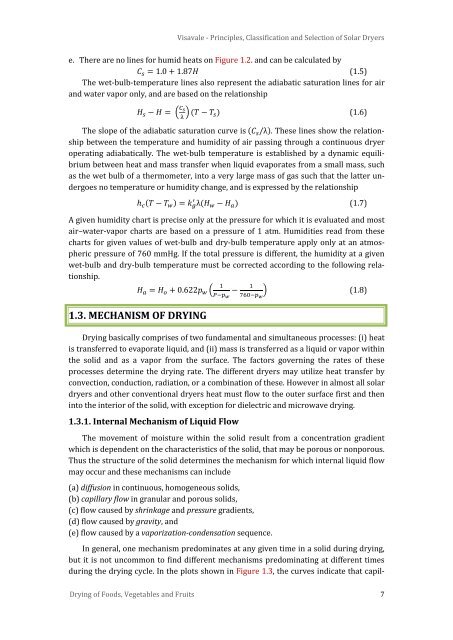Solar Drying: Fundamentals,Applications and Innovations - National ...
Solar Drying: Fundamentals,Applications and Innovations - National ...
Solar Drying: Fundamentals,Applications and Innovations - National ...
Create successful ePaper yourself
Turn your PDF publications into a flip-book with our unique Google optimized e-Paper software.
Visavale - Principles, Classification <strong>and</strong> Selection of <strong>Solar</strong> Dryers<br />
e. There are no lines for humid heats on Figure 1.2. <strong>and</strong> can be calculated by<br />
C s = 1.0 + 1.87H (1.5)<br />
The wet-bulb-temperature lines also represent the adiabatic saturation lines for air<br />
<strong>and</strong> water vapor only, <strong>and</strong> are based on the relationship<br />
H s − H = C s<br />
λ (T − T s) (1.6)<br />
The slope of the adiabatic saturation curve is (C s /λ). These lines show the relationship<br />
between the temperature <strong>and</strong> humidity of air passing through a continuous dryer<br />
operating adiabatically. The wet-bulb temperature is established by a dynamic equilibrium<br />
between heat <strong>and</strong> mass transfer when liquid evaporates from a small mass, such<br />
as the wet bulb of a thermometer, into a very large mass of gas such that the latter undergoes<br />
no temperature or humidity change, <strong>and</strong> is expressed by the relationship<br />
h c (T − T w ) = k g ′ λ(H w − H a ) (1.7)<br />
A given humidity chart is precise only at the pressure for which it is evaluated <strong>and</strong> most<br />
air–water-vapor charts are based on a pressure of 1 atm. Humidities read from these<br />
charts for given values of wet-bulb <strong>and</strong> dry-bulb temperature apply only at an atmospheric<br />
pressure of 760 mmHg. If the total pressure is different, the humidity at a given<br />
wet-bulb <strong>and</strong> dry-bulb temperature must be corrected according to the following relationship.<br />
H a = H o + 0.622p w 1<br />
− 1<br />
(1.8)<br />
P−p w 760−p w<br />
1.3. MECHANISM OF DRYING<br />
<strong>Drying</strong> basically comprises of two fundamental <strong>and</strong> simultaneous processes: (i) heat<br />
is transferred to evaporate liquid, <strong>and</strong> (ii) mass is transferred as a liquid or vapor within<br />
the solid <strong>and</strong> as a vapor from the surface. The factors governing the rates of these<br />
processes determine the drying rate. The different dryers may utilize heat transfer by<br />
convection, conduction, radiation, or a combination of these. However in almost all solar<br />
dryers <strong>and</strong> other conventional dryers heat must flow to the outer surface first <strong>and</strong> then<br />
into the interior of the solid, with exception for dielectric <strong>and</strong> microwave drying.<br />
1.3.1. Internal Mechanism of Liquid Flow<br />
The movement of moisture within the solid result from a concentration gradient<br />
which is dependent on the characteristics of the solid, that may be porous or nonporous.<br />
Thus the structure of the solid determines the mechanism for which internal liquid flow<br />
may occur <strong>and</strong> these mechanisms can include<br />
(a) diffusion in continuous, homogeneous solids,<br />
(b) capillary flow in granular <strong>and</strong> porous solids,<br />
(c) flow caused by shrinkage <strong>and</strong> pressure gradients,<br />
(d) flow caused by gravity, <strong>and</strong><br />
(e) flow caused by a vaporization-condensation sequence.<br />
In general, one mechanism predominates at any given time in a solid during drying,<br />
but it is not uncommon to find different mechanisms predominating at different times<br />
during the drying cycle. In the plots shown in Figure 1.3, the curves indicate that capil-<br />
<strong>Drying</strong> of Foods, Vegetables <strong>and</strong> Fruits 7

















